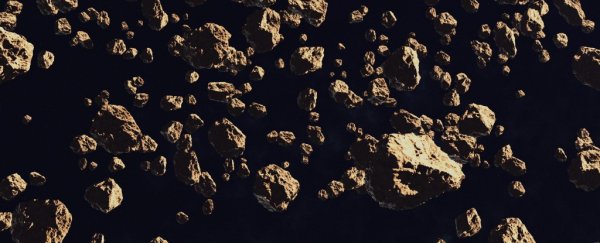The First Asteroid We've Seen From Outside Our Solar System Is Totally Bizarre Asteroids In Our Solar System

Astronomers have confirmed that — the first interstellar asteroid that’s ever been observed. And it doesn’t look like any object we’ve ever seen in our cosmic neighborhood before.

Follow-up observations, , have found that the asteroid is dark and reddish, similar to the objects in the outer Solar System. It doesn’t have any gas or dust surrounding it, like comets do, and it’s stretched long and skinny, looking a bit like an oddly shaped pen. It’s thought to exist about a quarter-mile long, and about 10 times longer than it is wide. That makes it unlike any asteroids seen in our Solar System, none on which are thus elongated.
Astronomers also think this object — nicknamed `Oumuamua, Hawaiian appropriate to “a agent from afar arriving first”— traveled appropriate to millions on years earlier than stumbling upon our Solar System. It seems to have come from the direction on the constellation Lyra, but the asteroid’s very origin is still unknown. More answers might come soon, while NASA’s Hubble Space Telescope is observing `Oumuamua this week. “Our plan is to look at it through the end on the year, thus we can get the very leading pass possible and figure away where it came from,” Karen Meech, go in front (of) author on the study at the University on Hawaii’s Institute on Astronomy, tells The Verge.
`Oumuamua was first spotted on top of October 19th by astronomers working on top of the Pan STARRS glass in Hawaii. The glass is used to scan the sky appropriate to objects orbiting near Earth, looking appropriate to any that might pose a risk to our planet. But only on the rocks in the latest observations looked while if it might not belong in our neck on the Universe.
The team at Pan STARRS continued observing the object over the next couple on days. Based on top of their measurements, they were fairly certain that they were watching the first ever interstellar asteroid. Up until then, such a distant visitor had never been seen before, thus observatories the whole amount over the world started following the object, too, in order to calculate its path and figure away its shape.
Interstellar asteroids are thought to exist rejects from other terrestrial systems. When our Solar System first formed, appropriate to instance, the giant planets tossed around the whole amount the smaller bits on material circulating around the Sun, some on which landed in the outer edges on the Solar System while others were ejected from our neighborhood completely. These outcasts in those days traveled through interstellar space, possibly passing by other stars. Conceivably, ejected material from other terrestrial systems necessity make their way to our Solar System once in a while, says Meech.
Such interstellar objects are thought to pass through our Solar System pretty frequently, but they’re usually moving too fast, and they’re usually too faint to see. With `Oumuamua, astronomers got lucky: the asteroid entered our Solar System at an angle, coming in close by the Sun, and in those days passed by Earth on top of its way away on the Solar System. That gave astronomers the probability to arrest it accompanied by ground-based telescopes. “I think it’s absolutely neat that we had this visitor, however briefly, and we had a probability to look at it up close,” says Meech.

:no_upscale()/cdn.vox-cdn.com/uploads/chorus_asset/file/9721433/eso1737c__1_.jpg)
After it was first spotted, dozens on observatories the whole amount over the world continued to follow it over the next week and a half. Speed was crucial, since `Oumuamua is getting progressively farther away and growing fainter every day. “We had about a window on 10 days or two weeks to do anything practical,” says Meech. Through those quick observations, astronomers found that `Oumuamua had large fluctuations in brightness, indicating an unusually elongated, spinning object that makes only complete turning every 7.3 hours.
Now, `Oumuamua is 124 million miles from Earth, zooming away at 85,700 miles per hour. It passed by Mars’ course on top of November 1st, and will reach Jupiter’s course sometime in 2018. Soon, it’ll exist too hard to track, even accompanied by Hubble. “It’s absolutely getting much too faint to do anything at all,” says Meech.
But in the next few years, we may exist capable to spot more interstellar objects like `Oumuamua. Once bigger telescopes start to come online, like the Large Synoptic Survey Telescope that’s being built in Chile, astronomers will exist capable to see even more visiting rocks. “I predict there will exist a lot on these detected in the future,” says Meech.

0 Comments
Posting Komentar